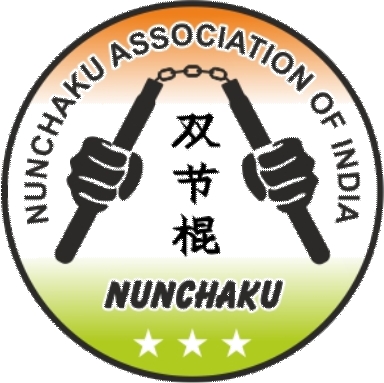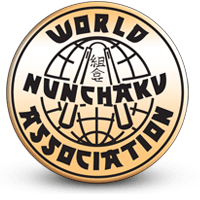About Nunchaku
The Nunchaku, also known as “dual-section stick,” “nunchuks,” “nunchucks,” “chainsticks,” or “chuka sticks” in English, is a traditional weapon in East-Asian martial arts. It consists of two sticks, traditionally made of wood, connected at their ends by a short metal chain or rope, measuring approximately 30 cm (12″) for the sticks and 1 inch for the rope. Those who practice with this weapon are called nunchakuka in Japanese.
Widely utilized in Southern Chinese Kung Fu, Okinawan Kobudo, and karate, the nunchaku serves as a training weapon, aiding in the development of quick hand movements and improved posture. While traditionally crafted from wood, modern versions may be made of metal, plastic, or fiberglass. Toy and replica versions, not intended for use as weapons, can be made from polystyrene foam or plastic. It’s important to note that the possession of nunchaku is prohibited in some countries, except for professional martial arts schools.
Origins of Nunchaku
The Chinese military text Wujing Zongyao, from the Northern Song dynasty, records a nunchaku-like weapon: “iron chain-linked sticks” used by Xirong on horses against Han infantry. Resembling farmer’s flails, iron-adorned, it excelled in striking from above. Theories suggest Southeast Asian influences, seen in the Philippine tabak-toyok for threshing. Alternative origins include an Okinawan horse bit (muge) or a clapper (hyoshiki) from night watch, attracting attention and warning of dangers. Claims of Okinawan weapons as peasant tools adapted due to weapon restrictions are likely romanticized, with martial arts historically practiced by Okinawan aristocracy, contradicting claims of exclusive peasant usage.
Parts
- Ana: the hole on the kontoh of each handle for the himo to pass through—only nunchaku that are connected by himo have an ana.
- Himo: the rope which connects the two handles of some nunchaku.
- Kusari: the chain which connects the two handles of some nunchaku.
- Kontoh: the top of each handle.
- Jukon-bu: the upper area of the handle.
- Chukon-bu: the center part of the handle.
- Kikon-bu: the lower part of the handle.
- Kontei: the bottom of the handle.
Construction
Nunchaku comprises two wooden sections linked by a cord or chain, with variations incorporating extra sections. In China, the striking stick is termed the “dragon stick” (“龍棍”), and the handle is the “yang stick” (“陽棍”).
For training, the rounded, comparatively heavy nunchaku is employed, while the octagonal variant is used in combat. Ideally, each piece should sufficiently shield the forearm when gripped near the top. Both ends are usually equal in length, though asymmetrical designs resembling traditional flails exist.
The connecting rope or chain’s ideal length allows comfortable hanging over the palm, sticks perpendicular to the ground. Proper weight balance is crucial; cheaper or novelty versions may hinder advanced “low-grip” moves. Well-balanced nunchaku, traditionally crafted from robust, flexible hardwood like oak, loquat, or pasania, facilitate ease and control of swing arcs.
Formal styles (Nunchaku Styles)
The nunchaku finds widespread use in Okinawan kobudō, karate, Korean hapkido, and Eskrima. Notably, the Tabak-Toyok, a distinct Philippine weapon, is employed, not the Okinawan variant. Each martial art style applies the nunchaku uniquely. Okinawan forms emphasize gripping and locking, while Filipino practitioners prioritize striking akin to stick usage. Korean systems integrate offensive and defensive maneuvers, encompassing both locks and strikes. Nunchaku features in Sembkalah (Iranian Monolingual Combat Style) for lethal defense and assault. Typically wielded single-handedly, it may also be dual-wielded, offering versatile techniques such as whirling for blunt force or immobilizing opponents by wrapping the chain around their weapon. Nunchaku training enhances hand speed, posture, and hand conditioning, serving as an effective introductory weapon to instill self-restraint in students.
Freestyle
Freestyle nunchaku represents a contemporary form of performance art that focuses on the visual aspects of nunchaku, emphasizing aesthetics over combat applications. The rise of the Internet has significantly expanded access to nunchaku, fostering increased interest in learning and showcasing freestyle techniques through various video-sharing platforms. Recognized by the World Nunchaku Association as a competition discipline, freestyle attracts enthusiasts worldwide. In modern martial arts, some schools incorporate nunchaku training to enhance students’ reflexes, hand control, and overall skills, acknowledging its value beyond traditional combat applications.
Legality
Nunchaku face legal restrictions in several countries. Bans, largely influenced by Bruce Lee’s film popularity, are evident in Norway, Canada, Russia, Poland, Chile, and Spain. Germany banned nunchaku in 2006, labeling them as strangling weapons. In the UK, public possession is restricted, though not explicitly prohibited, and Scotland has similar laws with a 2010 case clarifying their status. Hong Kong permits licensed rubber nunchaku but prohibits metal or wooden ones. Australia’s regulations vary by state, with New South Wales requiring a permit. In the U.S., 1970s state-level bans followed Bruce Lee’s popularity, but only Massachusetts maintains a ban today, classifying nunchaku as dangerous weapons with exemptions for martial arts use. Other states restrict specific situations like school grounds or government facilities.
Law enforcement use
Several American police departments have integrated nunchaku into their arsenal, a trend that gained momentum following the popularity of Bruce Lee movies in the 1970s. In 2015, Anderson, California’s police force received training in nunchaku usage for non-lethal applications, leveraging their dual function as striking weapons and control tools. The Orcutt Police Nunchaku (OPN) found adoption in over 200 law enforcement agencies across the USA, primarily employed for pain compliance through wrist and ankle grappling. While effective, instances of improper use leading to injuries, such as wrist and limb breaks, prompted their phased-out utilization. Tasers have since become the more prevalent non-lethal weapon of choice for many police departments.
Notable organizations of Nunchaku
- World Nunchaku Association
- Nunchaku Association of India
- I.R. Iran Nunchaku Association
- American Style Nunchaku
- North American Nunchaku Association
- Federation Nunchaku-do Belgium
- Nunchaku-do Brasil
- WNA Cameroon
- Jaco Martial Arts
- WNA France
- WNA Indonesia
- Stichting Nunchaku Nederland
- Nunchaku Norge
- Senegalese Association of Nunchaku-do
- Jukensh Nunchaku Club Tanzania
- Ken-Fu Nunchaku
- Hong Kong Nunchaku Association
- Long Quan Dao ASD
FAQ
Is nunchaku legal in India ?
Yes, nunchaku is legal in India. The Nunchaku Association of India promotes only official safety nunchaku, which are designed for safe practice and competition in accordance with international standards.
Do karate club offer nunchaku training as part of their curriculum?
Yes, many karate schools offer nunchaku training as part of their curriculum, especially those that focus on weapons training alongside traditional karate techniques. Nunchaku is often included in advanced training or as an additional skill to enhance coordination, precision, and weapon handling. However, it may vary by school and style, so it’s best to check with individual dojos.


